Advancing Physics-Inspired Computing
Professor Pedram Khalili co-chaired the 2025 International Workshop on Ising Machines, held in Evanston May 13 – 15
The Ising model in physics describes how subatomic particle spins interact and arrange themselves inside a magnetic material.
Ising machines, derived from the model, are one example of the emerging field of physics-inspired computing systems that replicate physical phenomena to increase the speed and improve the energy efficiency of certain computations.
Built using electronic, magnetic, photonic, or other platforms, hardware and software implementations of Ising machines demonstrate significant potential to tackle computationally complex challenges, including optimization problems related to logistics, finance, and AI.
Convening more than 100 physicists, computer scientists, electrical engineers, and mathematicians, Northwestern University hosted the 2025 International Workshop on Ising Machines (IISM) from May 13-15 in Evanston. Pedram Khalili, AT&T Research Professor of Electrical and Computer Engineering at Northwestern Engineering, served as conference co-chair with Kerem Camsari (University of California, Santa Barbara).

IISM 2025 covered a wide range of topics, including theoretical perspectives on Ising machines, digital applications, simulations of innovative computing paradigms, and hardware advances related to Ising machines.
Several Northwestern students and postdocs presented their work at the conference, including:
- Jordan Athas, a PhD candidate in electrical engineering, presented a talk on random number generation with field-free voltage-controlled magnetic tunnel junctions.
- Christian Duffee, a PhD candidate in electrical engineering, presented a talk on probabilistic computing with extended variables in a CMOS integrated circuit.
- Arthur Montanari, a postdoctoral researcher in physics and astronomy at the Center for Network Dynamics, presented a talk on designing disordered oscillator Ising machines for global optimization.
- William Rogers, a PhD student in applied physics, presented a poster on use of stray fields in a 2D square nanomagnet lattice for correlation and spectral engineering of random binary matrix generators.
“Northwestern has a culture of transdisciplinary collaboration and intellectual exploration, which means we are well-positioned to have a great impact in this field,” Khalili said. “The prospective applications of these machines also align exceptionally well with Northwestern's priorities in AI and sustainability.”

Five Northwestern faculty members served on the IISM 2025 scientific committee, providing guidance on the technical content of the workshop. Members included:
- Randall Berry, John A. Dever Chair of Electrical and Computer Engineering, McCormick School of Engineering
- Dongning Guo, professor of electrical and computer engineering and (by courtesy) computer science, Northwestern Engineering
- Ermin Wei, associate professor of electrical and computer engineering, industrial engineering and management sciences, and (by courtesy) computer science, Northwestern Engineering
- István Kovács, assistant professor of physics and astronomy, Northwestern’s Weinberg College of Arts and Sciences
- Adilson Motter, Charles E. and Emma H. Morrison Professor of Physics and Astronomy, Weinberg
Alan Sahakian, senior advisor to the dean and professor of electrical and computer engineering and (by courtesy) biomedical engineering at Northwestern Engineering, delivered opening remarks at the workshop.

“It was amazing to see how much progress has been achieved in the short time since the last conference,” Khalili said. “We saw examples of real-world applications starting to be addressed, while the physical implementation of these machines also continues to evolve. Many presentations included various exciting new ways of designing and co-designing the hardware and algorithms. I think we will see much more of this in the coming years as progress accelerates.”
The second annual IISM workshop was co-sponsored by the IEEE Magnetics Society, Northwestern University, Tohoku University, the Petaspin Association, and technically co-sponsored by the IEEE Nanotechnology Council (IEEE NTC).

